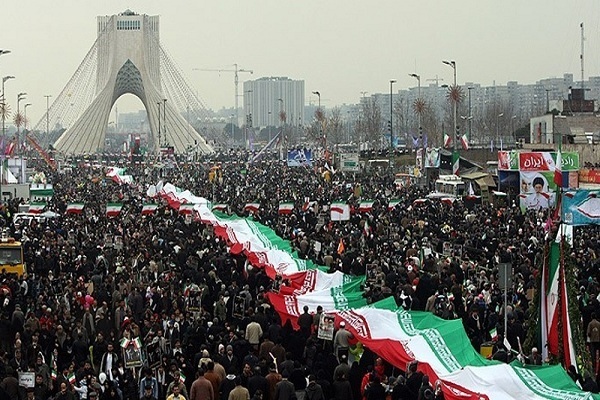Iranians Mark 46th Anniversary of Islamic Revolution with Nationwide Rallies

The officially commenced at 9:30 a.m. local time across Tehran and approximately 1,400 cities, towns, and districts, as well as 38,000 villages throughout Iran.
Despite cold weather conditions in the capital, large crowds gathered ahead of the official start time, demonstrating strong enthusiasm and commitment to the ideals of the 1979 Islamic Revolution.
Participants from all walks of life, including significant numbers of young people from the 2000s and 2010s generations, attended the rallies alongside their families, reflecting the continued engagement of Iran’s youth. The events also saw the presence of notable cultural and artistic figures.
The rallies featured various performances and displays, including parachute demonstrations and martial arts exhibitions by female athletes in Tehran’s Enghelab Square.
Symbolic displays were also part of the event, such as representations of the arrest of Israeli prime minister Benjamin Netanyahu, and the burning of effigies resembling former US President Donald Trump and Netanyahu.

Along the main rally routes, particularly from Imam Hussein Square to Azadi Square, more than 2,000 booths were set up offering cultural, artistic, informational, medical, and hospitality services.
These booths, organized by various civic groups, organizations, and governmental bodies, highlighted the achievements of the Islamic Revolution, including showcases of domestically produced industrial products.
Read More:
Thousands of choir groups performed nationwide, adding a musical dimension to the events. Religious recitations by eulogists also resonated along the rally routes.
Media coverage was extensive, with around 7,200 journalists, photographers, and cameramen from both domestic and international outlets reporting on the events.
The central ceremony in Tehran's Azadi Square began at 10:00 a.m. with a recitation from the Quran by an internationally acclaimed Qari, followed by the national anthem.
The event was attended by families of martyrs, veterans, military and government officials, diplomats, military attaches from foreign embassies, and international guests, including youth from resistance movements and prominent cultural and political figures from Islamic countries.
Read More:
Every year, millions of Iranians across the country observe ten days of celebrations marking the anniversary of the victory of the 1979 Islamic Revolution that put an end to the monarchy of the US-backed Pahlavi regime in the country.
The day of Imam Khomeini’s return to Iran marks the beginning of the Ten Day Fajr, which culminates with rallies on the anniversary of the victory of the Islamic Revolution (February 10 this year).
The Iranian nation toppled the US-backed Pahlavi regime 46 years ago, ending the 2,500 years of monarchic rule in the country.
The Islamic Revolution spearheaded by the late Imam Khomeini, established a new political system based on Islamic values and democracy.
4265057



